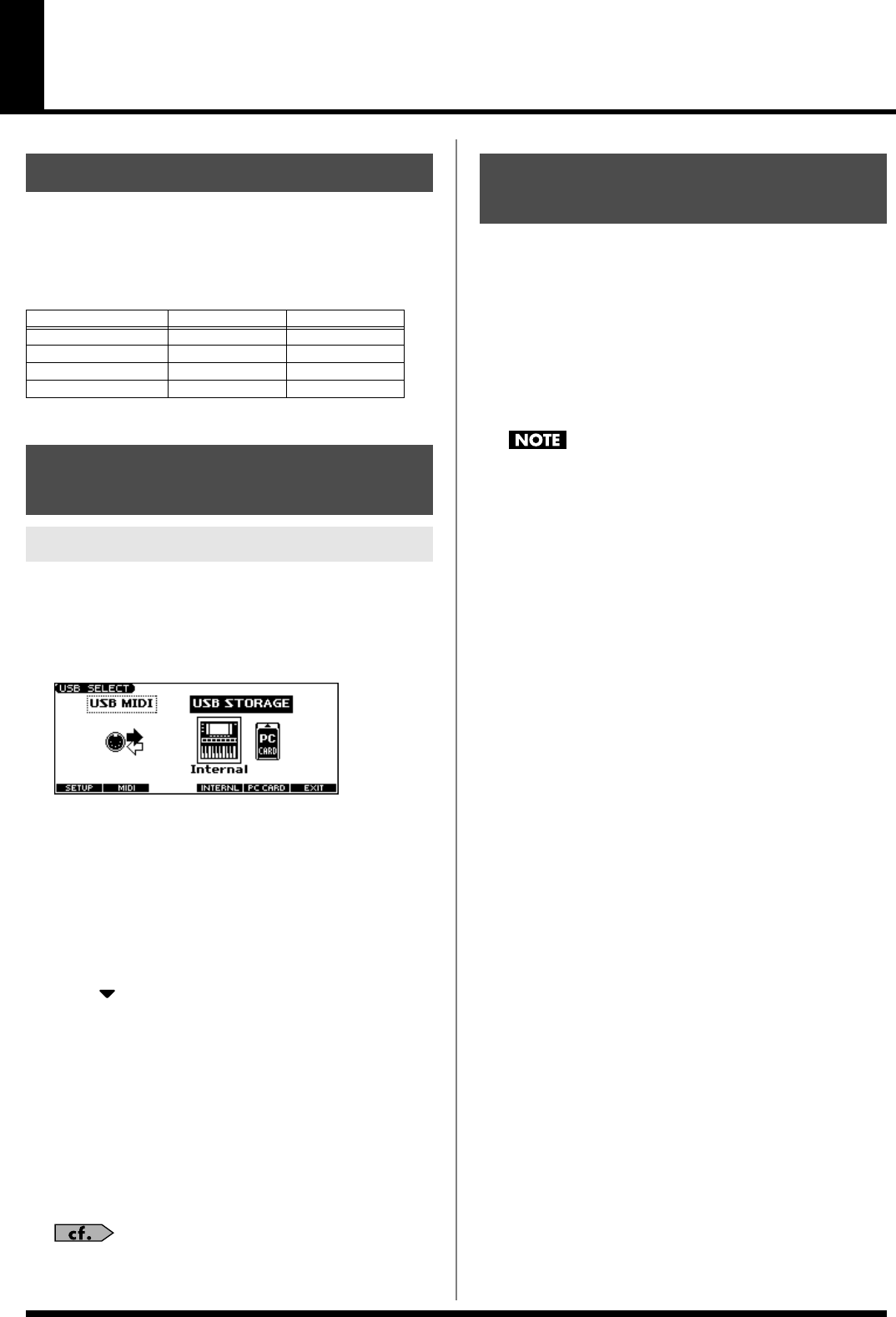
167
Connecting to Your Computer via USB
The JUNO-G has two modes of USB functionality:
storage mode
for
transferring files, and
MIDI mode
for sending and receiving MIDI
messages. You must switch between these two modes on the JUNO-
G; they cannot be used simultaneously.
Each mode can be used with the following operating systems.
* This may not work correctly with some types of computer.
* If you’ve selected USB MIDI mode, nothing can be received from the
MIDI IN connector.
1.
Press MODE [USB].
The USB SELECT screen appears.
2.
Press [F2 (MIDI)].
The USB connector will switch to MIDI mode.
* If USB Storage mode was selected, a warning will appear. Press [F6
(OK)] if you want to switch to MIDI mode. Press [F5 (CANCEL)] if
you decide to cancel.
3.
Press [F1 (SETUP)].
The SYSTEM SETUP USB screen will appear.
4.
Press [ ] to select “USB-MIDI Thru.”
5.
Use the VALUE dial or [INC] [DEC] to make settings for
USB-MIDI Thru.
This switch specifies whether MIDI messages received at the USB
connector or the MIDI IN connector will be retransmitted from the
USB connector or the MIDI OUT connector (ON) or not (OFF).
* If you want the JUNO-G to start up with the USB connector in MIDI
mode the next time it’s powered up, press [F6 (WRITE)] to save the
system settings.
6.
Press [EXIT] to return to the previous screen.
For details on operations in MIDI mode, refer to
Exchanging
MIDI Messages with Your Computer (MIDI Mode)
(p. 169).
By connecting the JUNO-G with your computer via a USB cable, you
can transfer files from Internal user area or a memory card to and
from the hard disk or other media of your computer, in order to back
up your data.
You can use software on your computer to edit wave data you’ve
created on the JUNO-G. Conversely, wave data that you’ve created
on your computer can be used on the JUNO-G.
In this way, USB Storage mode lets you transfer audio files to or
from a connected computer.
Never disconnect the USB cable or turn off the power if USB
Storage mode is selected.
1.
With the JUNO-G not connected, start up your computer.
2.
Use a USB cable to connect the JUNO-G to your computer.
3.
Turn on the power (POWER switch) of the JUNO-G.
4.
Press MODE [USB].
The USB SELECT screen appears.
5.
Press [F4 (INTERNAL)] or [F5 (PC CARD)] to connect with
your computer.
[F4 (INTERNAL)]: Connect to the user memory
[F5 (PC CARD)]: Connect to the memory card
* If MIDI mode was selected, a warning will appear. Press [F6 (OK)] if
you want to switch to USB Storage mode. Press [F5 (CANCEL)] if
you decide to cancel.
* To cancel the connection, press [F6 (EXIT)].
6.
When you make the connection, one of the following indications
will appear depending on the computer you’re using.
•
Windows XP users
A drive named “JUNO-G USER” will be displayed within My Computer.
Below that drive there will be folders named “ROLAND” and “TMP.”
•
Windows 2000 users
A drive named “Removable disk” will be displayed within My Computer.
Below that drive there will be folders named “ROLAND” and “TMP.”
•
Macintosh users
A drive icon named “JUNO-G USER” will appear on the desktop.
If a memory card is connected, the volume name of the memory
card will be displayed.
Below it will be folders named “ROLAND” and “TMP.”
About USB Functions
Operating System
Storage Mode MIDI Mode
Windows XP/2000r
✔
✔
Windows Me
✔
not supported
Mac OS X
✔
✔
Mac OS 9
✔
not supported
Selecting the USB Operating
Mode
Using MIDI Mode
Transferring Files to or from
Your Computer (Storage Mode)
JUNO-G_e.book 167 ページ 2006年2月13日 月曜日 午後2時44分
